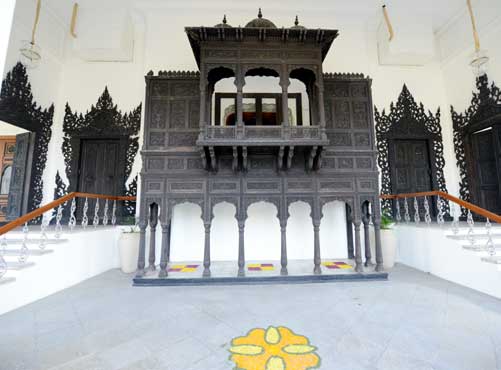The Coronation Hall at Taj Falaknuma, which has been thrown open for public viewing after months of cleaning and refurbishing, is all set to give visitors a great experience of witnessing four different faiths under one roof. The restoration of the hall was done under the guidance of Princess Esra Birgin and experts from UK. It was in a decrepit condition with the roof falling apart and the carving turning black due to pigeon poop.
It is after several months of cleaning and polishing that fragrance of sandalwood filled the room, allowing one to cross the corridors admiring its art, sculpture and wood carvings. Sharing his views, raconteur Prabhakar Mahindrakar said, “In 1903, when the sixth Nizam Mir Mahboob Ali Khan attended the coronation of King Edward at Dilli Darbar, a lot of artists and craftsmen came to showcase their work at the mela expecting huge sales.
Unfortunately, no ruler took interest in purchasing the works and the artisans were left disappointed, except for the Nizam of Hyderabad who bought this ‘four-religion art’, which was immediately shipped to the city.” The Coronation Hall, which was used by royal women members and the Nizam, has many interesting facts to entice visitors. It took nearly three years for the Nizam to get the single unit art work to be put on proper display at the hall.
The intricate wood carvings are made in sandalwood and rosewood, which have certain unique features that pinpoint to the secular rule which prevailed during the Nizamera. Palace historian PrabhakarMahindrakar said, “The hall is divided into five sections, each dedicated to a distinct faith. The room begins with the Mughal art and is followed by Thai, Buddhism and comes to an end with Hinduism.
The first section of the room has intricate carving of ‘Tree of life’ in sandalwood on both sides of the hall, and on to the right one can also see the replica of ‘Emperor Jahangir darbar’ which was used by the Nizam to look at the city.” Walking down further, one would be welcomed with huge sandalwood arches which depict the temples of Thai monks and other carvings include Yali and peacocks which play a prominent role in Thai culture.
The next is Buddhism arch which depicts the royal life of ‘Gautam Buddha’ on one side and enlightenment and penance on the other side. The last depicts, Hinduism, where there is a replica of Panchavati, the abode of Ram-Sita while in exile along with many other mythological figures related to Lord Krishna, Goddess Lakshmi, Lord Vinayaka and many more.
source: http://www.metroindia.com / Metro India / Home> LifeStyle> Places / by Metro India News / November 28th, 2015









